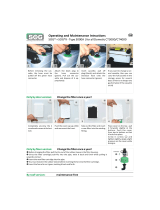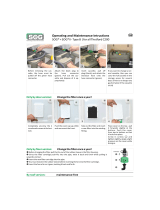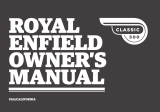Page is loading ...

PRINTED IN JAPAN
2002.05-0.5×1 CR
(E)
PRINTED ON RECYCLED PAPER
YAMAHA MOTOR CO., LTD.
4XY-28199-14LIT-11626-16-15
XVZ13TFR(C)
XVZ13TFSR(C)
OWNER’S MANUAL

EAU03438

EAU00002
INTRODUCTION
Congratulations on your purchase of the Yamaha Royal Star™ VENTURE
®
. This
model is the result of Yamaha’s vast experience in the production of fine sporting,
touring, and pacesetting racing machines. It represents the high degree of crafts-
manship and reliability that have made Yamaha a leader in these fields.
This manual will give you an understanding of the operation, inspection, and basic
maintenance of this motorcycle. If you have any questions concerning the operation
or maintenance of your motorcycle, please consult a Yamaha dealer.
The design and manufacture of this Yamaha motorcycle fully comply with the emis-
sions standards for clean air applicable at the date of manufacture. Yamaha has met
these standards without reducing the performance or economy of operation of the
motorcycle. To maintain these high standards, it is important that you and your
Yamaha dealer pay close attention to the recommended maintenance schedules and
operating instructions contained within this manual.
U4XY14.book Page 1 Thursday, May 30, 2002 3:40 PM

EAU00003
IMPORTANT MANUAL INFORMATION
Particularly important information is distinguished in this manual by the following notations:
The Safety Alert Symbol means ATTENTION! BECOME ALERT! YOUR SAFETY IS
INVOLVED!
WARNING
Failure to follow WARNING instructions could result in severe injury or death to the
motorcycle operator, a bystander or a person inspecting or repairing the motorcycle.
CAUTION:
A CAUTION indicates special precautions that must be taken to avoid damage to the
motorcycle.
NOTE:
A NOTE provides key information to make procedures easier or clearer.
NOTE:
@
●
This manual should be considered a permanent part of this motorcycle and should remain
with it even if the motorcycle is subsequently sold.
●
Yamaha continually seeks advancements in product design and quality. Therefore, while
this manual contains the most current product information available at the time of printing,
there may be minor discrepancies between your motorcycle and this manual. If you have
any questions concerning this manual, please consult your Yamaha dealer.
@
U4XY14.book Page 1 Thursday, May 30, 2002 3:40 PM

IMPORTANT MANUAL INFORMATION
EW000000
WARNING
@
PLEASE READ THIS MANUAL AND THE “YOU AND YOUR MOTORCYCLE: RIDING
TIPS” BOOKLET CAREFULLY AND COMPLETELY BEFORE OPERATING THIS MOTOR-
CYCLE. DO NOT ATTEMPT TO OPERATE THIS MOTORCYCLE UNTIL YOU HAVE AT-
TAINED ADEQUATE KNOWLEDGE OF ITS CONTROLS AND OPERATING FEATURES
AND UNTIL YOU HAVE BEEN TRAINED IN SAFE AND PROPER RIDING TECHNIQUES.
REGULAR INSPECTIONS AND CAREFUL MAINTENANCE, ALONG WITH GOOD RIDING
SKILLS, WILL ENSURE THAT YOU SAFELY ENJOY THE CAPABILITIES AND THE RELI-
ABILITY OF THIS MOTORCYCLE.
@
U4XY14.book Page 2 Thursday, May 30, 2002 3:40 PM

IMPORTANT MANUAL INFORMATION
AFFIX DEALER
LABEL HERE
EAU04247
XVZ13TFR(C)/XVZ13TFSR(C)
OWNER’S MANUAL
©2002 by Yamaha Motor Corporation, U.S.A.
1st edition, April 2002
All rights reserved.
Any reprinting or unauthorized use
without the written permission of
Yamaha Motor Corporation, U.S.A.
is expressly prohibited.
Printed in Japan.
P/N LIT-11626-16-15
U4XY14.book Page 3 Thursday, May 30, 2002 3:40 PM

TABLE OF CONTENTS
1 SAFETY INFORMATION
1
2 DESCRIPTION
2
3 INSTRUMENT AND CONTROL FUNCTIONS
3
4 AUDIO SYSTEM AND CB RADIO
4
5 PRE-OPERATION CHECKS
5
6 OPERATION AND IMPORTANT RIDING POINTS
6
7 PERIODIC MAINTENANCE AND MINOR REPAIR
7
8 CLEANING AND STORAGE
8
9 SPECIFICATIONS
9
10 CONSUMER INFORMATION
10
INDEX
EAU00009
U4XY14.book Page 1 Thursday, May 30, 2002 3:40 PM

SAFETY INFORMATION
1
Safe riding .......................................................................................... 1-1
Protective apparel .............................................................................. 1-3
Modifications ...................................................................................... 1-3
Loading and accessories ................................................................... 1-3
Gasoline and exhaust gas.................................................................. 1-5
Location of important labels .............................................................. 1-7
U4XY14.book Page 1 Thursday, May 30, 2002 3:40 PM

1
1-1
1-
SAFETY INFORMATION
EAU03633
MOTORCYCLES ARE SINGLE TRACK VEHICLES. THEIR SAFE USE AND OPERATION ARE
DEPENDENT UPON THE USE OF PROPER RIDING TECHNIQUES AS WELL AS THE EXPERTISE
OF THE OPERATOR. EVERY OPERATOR SHOULD KNOW THE FOLLOWING REQUIREMENTS
BEFORE RIDING THIS MOTORCYCLE.
HE OR SHE SHOULD:
1. OBTAIN THOROUGH INSTRUCTIONS FROM A COMPETENT SOURCE ON ALL ASPECTS OF
MOTORCYCLE OPERATION.
2. OBSERVE THE WARNINGS AND MAINTENANCE REQUIREMENTS IN THE OWNER’S MANUAL.
3. OBTAIN QUALIFIED TRAINING IN SAFE AND PROPER RIDING TECHNIQUES.
4. OBTAIN PROFESSIONAL TECHNICAL SERVICE AS INDICATED BY THE OWNER’S MANUAL
AND/OR WHEN MADE NECESSARY BY MECHANICAL CONDITIONS.
Safe riding
1. Always make pre-operation checks. Careful checks may help prevent an accident.
2. This motorcycle is designed to carry the operator and a passenger.
3. The failure of motorists to detect and recognize motorcycles in traffic is the predominating cause of
automobile/motorcycle accidents. Many accidents have been caused by an automobile driver who
did not see the motorcycle. Making yourself conspicuous appears to be very effective in reducing the
chance of this type of accident.
Therefore:
a. Wear a brightly colored jacket.
b. Use extra caution when approaching and passing through intersections, since intersections are
the most likely places for motorcycle accidents to occur.
c. Ride where other motorists can see you. Avoid riding in another motorist’s blind spot.
U4XY14.book Page 1 Thursday, May 30, 2002 3:40 PM

SAFETY INFORMATION
1
1-2
4. Many motorcycle accidents involve inexperienced operators. In fact, many operators who have been
involved in accidents do not even have a current motorcycle license.
a. Make sure that you are qualified and that you only lend your motorcycle to other qualified opera-
tors.
b. Know your skills and limits. Staying within your limits may help you to avoid an accident.
c. We recommend that you practice riding your motorcycle where there is no traffic until you have
become thoroughly familiar with the motorcycle and all of its controls.
5. Many motorcycle accidents have been caused by error of the motorcycle operator. A typical error
made by the operator is veering wide on a turn due to EXCESSIVE SPEED or undercornering (insuf-
ficient lean angle for the speed).
a. Always obey the speed limit and never travel faster than warranted by road and traffic conditions.
b. Always signal before turning or changing lanes. Make sure that other motorists can see you.
6. The posture of the operator and passenger is important for proper control.
a. The operator should keep both hands on the handlebar and both feet on the operator footrests
during operation to maintain control of the motorcycle.
b. The passenger should always hold onto the operator, seat strap, or grab bar, if equipped, with
both hands and keep both feet on the passenger footrests.
c. Never carry a passenger unless he or she can firmly place both feet on the passenger footrests.
7. Never ride under the influence of alcohol or other drugs.
8. This motorcycle is designed for on-road use only, therefore, it is not suitable for off-road use.
U4XY14.book Page 2 Thursday, May 30, 2002 3:40 PM

SAFETY INFORMATION
1
1-3
Protective apparel
The majority of fatalities from motorcycle accidents are the result of head injuries. The use of a safety
helmet is the single most critical factor in the prevention or reduction of head injuries.
1. Always wear an approved helmet.
2. Wear a face shield or goggles. Wind in your unprotected eyes could contribute to an impairment of vi-
sion which could delay seeing a hazard.
3. The use of a jacket, heavy boots, trousers, gloves, etc., is effective in preventing or reducing abra-
sions or lacerations.
4. Never wear loose-fitting clothes, otherwise they could catch on the control levers, footrests, or wheels
and cause injury or an accident.
5. Never touch the engine or exhaust system during or after operation. They become very hot and can
cause burns. Always wear protective clothing that covers your legs, ankles, and feet.
6. Passengers should also observe the precautions mentioned above.
Modifications
Modifications made to this motorcycle not approved by Yamaha, or the removal of original equipment,
may render the motorcycle unsafe for use and may cause severe personal injury. Modifications may
also make your motorcycle illegal to use.
Loading and accessories
Adding accessories or cargo to your motorcycle can adversely affect stability and handling if the
weight distribution of the motorcycle is changed. To avoid the possibility of an accident, use extreme
caution when adding cargo or accessories to your motorcycle. Use extra care when riding a
motorcycle that has added cargo or accessories. Here are some general guidelines to follow if loading
cargo or adding accessories to your motorcycle:
U4XY14.book Page 3 Thursday, May 30, 2002 3:40 PM

SAFETY INFORMATION
1
1-4
Loading
The total weight of the operator, passenger, accessories and cargo must not exceed the maximum
load limit of XVZ13TF(C)/XVZ13TFS(C): 419 lb (190 kg). When loading within this weight limit, keep
the following in mind:
1. Cargo and accessory weight should be kept as low and close to the motorcycle as possible. Make
sure to distribute the weight as evenly as possible on both sides of the motorcycle to minimize imbal-
ance or instability.
2. Shifting weights can create a sudden imbalance. Make sure that accessories and cargo are securely
attached to the motorcycle before riding. Check accessory mounts and cargo restraints frequently.
3. Never attach any large or heavy items to the handlebar, front fork, or front fender. These items, in-
cluding such cargo as sleeping bags, duffel bags, or tents, can create unstable handling or slow
steering response.
Accessories
Genuine Yamaha accessories have been specifically designed for use on this motorcycle. Since
Yamaha cannot test all other accessories that may be available, you must personally be responsible
for the proper selection, installation and use of non-Yamaha accessories. Use extreme caution when
selecting and installing any accessories.
Keep the following guidelines in mind, as well as those provided under “Loading” when mounting acces-
sories.
1. Never install accessories or carry cargo that would impair the performance of your motorcycle. Care-
fully inspect the accessory before using it to make sure that it does not in any way reduce ground
clearance or cornering clearance, limit suspension travel, steering travel or control operation, or ob-
scure lights or reflectors.
U4XY14.book Page 4 Thursday, May 30, 2002 3:40 PM

SAFETY INFORMATION
1
1-5
a. Accessories fitted to the handlebar or the front fork area can create instability due to improper
weight distribution or aerodynamic changes. If accessories are added to the handlebar or front
fork area, they must be as lightweight as possible and should be kept to a minimum.
b. Bulky or large accessories may seriously affect the stability of the motorcycle due to aerodynamic
effects. Wind may attempt to lift the motorcycle, or the motorcycle may become unstable in cross
winds. These accessories may also cause instability when passing or being passed by large ve-
hicles.
c. Certain accessories can displace the operator from his or her normal riding position. This improp-
er position limits the freedom of movement of the operator and may limit control ability, therefore,
such accessories are not recommended.
2. Use caution when adding electrical accessories. If electrical accessories exceed the capacity of the
motorcycle’s electrical system, an electric failure could result, which could cause a dangerous loss of
lights or engine power.
Gasoline and exhaust gas
1. GASOLINE IS HIGHLY FLAMMABLE:
a. Always turn the engine off when refueling.
b. Take care not to spill any gasoline on the engine or exhaust system when refueling.
c. Never refuel while smoking or in the vicinity of an open flame.
2. Never start the engine or let it run for any length of time in a closed area. The exhaust fumes are poi-
sonous and may cause loss of consciousness and death within a short time. Always operate your
motorcycle in an area that has adequate ventilation.
3. Always turn the engine off before leaving the motorcycle unattended and remove the key from the
main switch. When parking the motorcycle, note the following:
U4XY14.book Page 5 Thursday, May 30, 2002 3:40 PM

SAFETY INFORMATION
1
1-6
a. The engine and exhaust system may be hot, therefore, park the motorcycle in a place where pe-
destrians or children are not likely to touch these hot areas.
b. Do not park the motorcycle on a slope or soft ground, otherwise it may fall over.
c. Do not park the motorcycle near a flammable source (e.g. a kerosene heater, or near an open
flame), otherwise it could catch fire.
4. When transporting the motorcycle in another vehicle, make sure that it is kept upright and that the fuel
cock is turned to “ON” or “RES” (for vacuum type) / “OFF” (for manual type). If it should lean over,
gasoline may leak out of the carburetor or fuel tank.
5. If you should swallow any gasoline, inhale a lot of gasoline vapor, or allow gasoline to get into your
eyes, see your doctor immediately. If any gasoline spills on your skin or clothing, immediately wash
the affected area with soap and water and change your clothes.
U4XY14.book Page 6 Thursday, May 30, 2002 3:40 PM

SAFETY INFORMATION
1
1-7
EAU02977
Location of important labels
Please read the following important labels carefully before operating this motorcycle.
U4XY14.book Page 7 Thursday, May 30, 2002 3:40 PM

SAFETY INFORMATION
1
1-8
CAUTION
Cleaning with alkaline or
acid cleaner, gasoline or
solvent will damage
windshield.
Use neutral detergent.
5JW-00
(5JW-2835Y-00)
12
3
4
5 CALIFORNIA ONLY
U4XY14.book Page 8 Thursday, May 30, 2002 3:40 PM

DESCRIPTION
2
Left view ............................................................................................. 2-1
Right view........................................................................................... 2-2
Controls and instruments ................................................................... 2-3
U4XY14.book Page 1 Thursday, May 30, 2002 3:40 PM

2-1
2
EAU00026
2-
DESCRIPTION
Royal Star
™
VENTURE
®
Left view
1. Shift pedal (page 3-9)
2. Starter (choke) knob (page 3-13)
3. Fuel tank cap (page 3-10)
4. Fuel cock (page 3-12)
5. Battery (page 7-34)
6. Coolant reservoir (page 7-17)
7. Fuse box 2 (page 7-36)
8. Side case (page 3-15)
9. Helmet holder (page 3-14)
10. Tail/brake light (page 7-38)
11. Rear turn signal lights (page 7-38)
U4XY14.book Page 1 Thursday, May 30, 2002 3:40 PM

DESCRIPTION
2-2
2
Royal Star
™
VENTURE
®
Right view
12. Muffler
13. Owner’s tool kit (page 7-2)
14. Helmet holder (page 3-14)
15. Travel trunk (page 3-16)
16. Passenger seat
17. Shock absorber assembly air valve (page 3-18)
18. Rider seat (page 3-13)
19. Fuel tank (page 3-11)
20. Front fork air valve (page 3-17)
21. Headlight (page 7-37)
22. Front turn signal/position lights (page 7-38)
23. Fuse box 1 (page 7-35)
24. Brake pedal (page 3-10)
25. Rider footrest
26. Passenger footrest
U4XY14.book Page 2 Thursday, May 30, 2002 3:40 PM

DESCRIPTION
2-3
2
Royal Star
™
VENTURE
®
Controls and instruments
1. Clutch lever (page 3-9)
2. Audio system/CB radio control unit (page 4-3)
3. Left handlebar switches (page 3-7)
4. Rider headset jack (page 4-2)
5. Speedometer unit (page 3-4)
6. Main switch/steering lock (page 3-1)
7. Right handlebar switches (page 3-8)
8. Throttle grip (page 7-21)
9. Brake lever (page 3-9)
U4XY14.book Page 3 Thursday, May 30, 2002 3:40 PM
/


